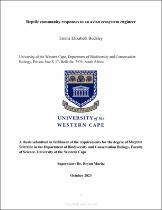| dc.description.abstract | In the Kalahari, sociable weavers (Philetairus socius) build huge, communal nests. Although Kalahari tree skinks (Trachylepis spilogaster) are known to preferentially use trees that host such colonies, the degree to which other reptile species use these trees is not well documented. Sociable weaver nests can provide benefits to different animals and can provide food and shelter for reptiles. I trapped reptiles at Tswalu Kalahari Reserve to assess the impact of sociable weaver colonies on selected reptile populations during weaver breeding and non-breeding seasons. I tested the hypothesis that the reptile community under trees with colonies would differ in diversity compared to those at nearby control trees without colonies, because the sociable weaver colonies provide more resources (food and shelter) to the reptiles than trees without colonies. I also tested whether the abundance of the Kalahari tree skink, Cape cobra (Naja nivea), and Cape thick-toed gecko (Pachydactylus capensis) under trees with colonies differed from those at nearby control trees without colonies, as these were the most abundant species found at the sociable weaver nests. Trapping for 11 days at 24 sites (12 colony trees, 12 control trees), on two occasions, once in March when weavers were breeding, and once in September before they were breeding, resulted in 665 total detections of 13 reptile species, including 148 total recaptures. Mean species richness was significantly higher at colony trees than at control trees during both surveys (2.5 times higher when the birds were breeding; 1.6 times higher when the birds were not breeding). Poisson N-mixture modelling revealed that Kalahari tree skink was significantly more abundant on colony trees during the breeding (3.2 times) and non-breeding seasons (3.7 times). | en_US |

